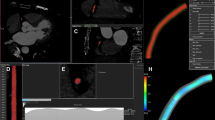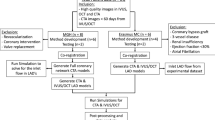Abstract
Characterization of endothelial shear stress (ESS) may allow for prediction of the progression of atherosclerosis. The aim of this investigation was to develop a non-invasive approach for in vivo assessment of ESS by coronary computed tomography angiography (CTA) and to compare it with ESS derived from invasive coronary angiography (ICA). A total of 41 patients with mild or intermediate coronary stenoses who underwent both CTA and ICA were included in the analysis. Two geometrical models of the interrogated vessels were reconstructed separately from CTA and ICA images. Subsequently, computational fluid dynamics were applied to calculate the ESS, from which ESSCTA and ESSICA were derived, respectively. Comparisons between ESSCTA and ESSICA were performed on 163 segments of 57 vessels in the CTA and ICA models. ESSCTA and ESSICA were similar: mean ESS: 4.97 (4.37–5.57) Pascal versus 4.86 (4.27–5.44) Pascal, p = 0.58; minimal ESS: 0.86 (0.67–1.05) Pascal versus 0.79 (0.63–0.95) Pascal, p = 0.37; and maximal ESS: 14.50 (12.62–16.38) Pascal versus 13.76 (11.44–16.08) Pascal, p = 0.44. Good correlations between the ESSCTA and the ESSICA were observed for the mean (r = 0.75, p < 0.001), minimal (r = 0.61, p < 0.001), and maximal (r = 0.62, p < 0.001) ESS values. In conclusion, geometrical reconstruction by CTA yields similar results to ICA in terms of segment-based ESS calculation in patients with low and intermediate stenoses. Thus, it has the potential of allowing combined local hemodynamic and plaque morphologic information for risk stratification in patients with coronary artery disease.



Similar content being viewed by others
Abbreviations
- ADCT:
-
320-Row area detector CT
- CFD:
-
Computational fluid dynamics
- CTA:
-
Computed tomography angiography
- DSCT:
-
128-Slice dual-source CT
- ESS:
-
Endothelial shear stress
- ICA:
-
Invasive coronary angiography
- IVUS:
-
Intravascular ultrasound
- MLA:
-
Minimum lumen area
- OCT:
-
Optical coherence tomography
- QCA:
-
Quantitative coronary angiography
- VFR:
-
Volumetric flow rate
References
Malek AM et al (1999) Hemodynamic shear stress and its role in atherosclerosis. JAMA 282(1):2035–2042
Cheng C et al (2006) Atherosclerotic lesion size and vulnerability are determined by patterns of fluid shear stress. Circulation 113(23):2744–2753
Samady H et al (2011) Coronary artery wall shear stress is associated with progression and transformation of atherosclerotic plaque and arterial remodeling in patients with coronary artery disease. Circulation 124(7):779–788
Chatzizisis YS et al (2008) Prediction of the localization of high-risk coronary atherosclerotic plaques on the basis of low endothelial shear stress: an intravascular ultrasound and histopathology natural history study. Circulation 117(8):993–1002
Frangos SG, Gahtan V, Sumpio B (1999) Localization of atherosclerosis: role of hemodynamics. Arch Surg 134(10):1142–1149
Chatzizisis YS et al (2007) Role of endothelial shear stress in the natural history of coronary atherosclerosis and vascular remodeling: molecular, cellular, and vascular behavior. J Am Coll Cardiol 49(25):2379–2393
Wentzel JJ et al (2003) Extension of increased atherosclerotic wall thickness into high shear stress regions is associated with loss of compensatory remodeling. Circulation 108(1):17–23
Asakura T, Karino T (1990) Flow patterns and spatial distribution of atherosclerotic lesions in human coronary arteries. Circ Res 66(4):1045–1066
Tadjfar M (2004) Branch angle and flow into a symmetric bifurcation. J Biomech Eng 126(4):516–518
Krams R (1997) Evaluation of endothelial shear stress and 3D geometry as factors determining the development of atherosclerosis and remodeling in human coronary arteries in vivo. Combining 3D reconstruction from angiography and IVUS (ANGUS) with computational fluid dynamics. Arterioscler Thromb Vasc Biol 17(10):2061–2065
Stone PH et al (2012) Prediction of progression of coronary artery disease and clinical outcomes using vascular profiling of endothelial shear stress and arterial plaque characteristics: the PREDICTION Study. Circulation 126(2):172–181
Stone PH et al (2007) Regions of low endothelial shear stress are the sites where coronary plaque progresses and vascular remodelling occurs in humans: an in vivo serial study. Eur Heart J 28(6):705–710
Li Y et al (2015) Impact of side branch modeling on computation of endothelial shear stress in coronary artery disease: coronary tree reconstruction by fusion of 3D angiography and OCT. J Am Coll Cardiol 66(2):125–135
Frauenfelder T et al (2007) In-vivo flow simulation in coronary arteries based on computed tomography datasets: feasibility and initial results. Eur Radiol 17(5):1291–1300
Frauenfelder T et al (2007) Flow and wall shear stress in end-to-side and side-to-side anastomosis of venous coronary artery bypass grafts. Biomed Eng Online 6:35
Goubergrits L et al (2008) CFD analysis in an anatomically realistic coronary artery model based on non-invasive 3D imaging: comparison of magnetic resonance imaging with computed tomography. Int J Cardiovasc Imaging 24(4):411–421
Giannopoulos AA et al (2016) Quantifying the effect of side branches in endothelial shear stress estimates. Atherosclerosis 251:213–218
Liu L et al (2016) The impact of image resolution on computation of fractional flow reserve: coronary computed tomography angiography versus 3-dimensional quantitative coronary angiography. Int J Cardiovasc Imaging 32(3):513–523
De Graaf MA et al (2013) Automatic quantification and characterization of coronary atherosclerosis with computed tomography coronary angiography: cross-correlation with intravascular ultrasound virtual histology. Int J Cardiovasc Imaging 29(5):1177–1190
Tu S et al (2012) In vivo comparison of arterial lumen dimensions assessed by co-registered three-dimensional (3D) quantitative coronary angiography, intravascular ultrasound and optical coherence tomography. Int J Cardiovasc Imaging 28(6):1315–1327
Tu S et al (2016) Diagnostic accuracy of fast computational approaches to derive fractional flow reserve from diagnostic coronary angiography: the international multicenter FAVOR pilot study. JACC Cardiovasc Interv 9(19):2024–2035
Tu S et al (2014) Fractional flow reserve calculation from 3-dimensional quantitative coronary angiography and TIMI frame count: a fast computer model to quantify the functional significance of moderately obstructed coronary arteries. JACC Cardiovasc Interv 7(7):768–777
Barlis P et al (2015) Reversal of flow between serial bifurcation lesions: insights from computational fluid dynamic analysis in a population-based phantom model. EuroIntervention 11(5):e1–e3
Toutouzas K et al (2015) Accurate and reproducible reconstruction of coronary arteries and endothelial shear stress calculation using 3D OCT: comparative study to 3D IVUS and 3D QCA. Atherosclerosis 240(2):510–519
Hetterich H et al (2015) Coronary computed tomography angiography based assessment of endothelial shear sress and its association with atherosclerotic plaque distribution in-vivo. PLoS One 10(1):e0115408
Motoyama S et al (2009) Computed tomographic angiography characteristics of atherosclerotic plaques subsequently resulting in acute coronary syndrome. J Am Coll Cardiol 54(1):49–57
Park HB et al (2015) Atherosclerotic plaque characteristics by CT angiography identify coronary lesions that cause ischemia: a direct comparison to fractional flow reserve. JACC Cardiovasc Imaging 8(1):1–10
Chatzizisis YS et al (2016) Association of global and local low endothelial shear stress with high-risk plaque using intracoronary 3D optical coherence tomography: Introduction of ‘shear stress score’. Eur Heart J Cardiovasc Imaging. doi:10.1093/ehjci/jew134
Acknowledgments
The authors acknowledged Saeb R. Lamooki for his contribution in preparing the manuscript and data management. S. Tu acknowledges the support by The Program for Professor of Special Appointment (Eastern Scholar) at Shanghai Institutions of Higher Learning, The Shanghai Pujiang Program (No. 15PJ1404200), the National Natural Science Foundation of China (Grants 31500797 and 81570456) and the National Key Research Program of China (Grant 2016YFC0100500). W. Yang acknowledges the support by the National Natural Science Foundation of China (Grants 81501467). J. Pu acknowledges the support by the National Science Fund for Distinguished Young Scholars (81625002), Program for New Century Excellent Talents in University from Ministry of Education of China (NCET-12-0352), Shanghai Shuguang Program (12SG22) and Shanghai Gaofeng Clinical Medicine Program (20152209).
Author information
Authors and Affiliations
Corresponding authors
Ethics declarations
Conflict of interest
Y. Li and P. Kitslaar are employed by Medis medical imaging systems bv and have a research appointment at the Leiden University Medical Center (LUMC). John H. C. Reiber is the CEO of Medis, and has a part-time appointment at LUMC as Prof of Medical Imaging. S. Tu receives research grant support from Medis. All other authors declare that they have no conflict of interest.
Rights and permissions
About this article
Cite this article
Huang, D., Muramatsu, T., Li, Y. et al. Assessment of endothelial shear stress in patients with mild or intermediate coronary stenoses using coronary computed tomography angiography: comparison with invasive coronary angiography. Int J Cardiovasc Imaging 33, 1101–1110 (2017). https://doi.org/10.1007/s10554-016-1003-0
Received:
Accepted:
Published:
Issue Date:
DOI: https://doi.org/10.1007/s10554-016-1003-0




